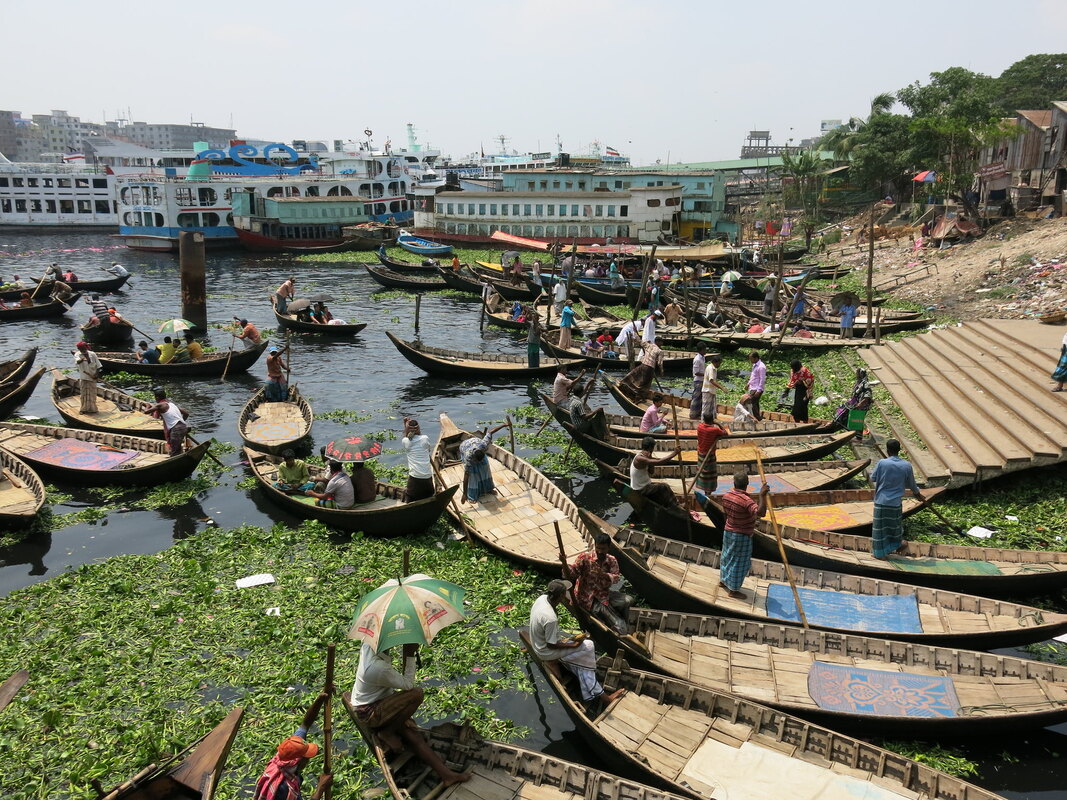BANGLADESH
|
What do I know about Bangladesh? Nothing. Guidebooks provide very little insight. There's few books written or TV episodes created that offer a glimpse into the eighth most populated country in the world.
The few travelers I've met who have been to Bangladesh said its a "great" place. They cautioned that poor infrastructure makes seemingly close distances take much longer to cover. Having no interest in seeing a beach (Cox's Bazar) or the Suburbans (which I visted from Calcutta) I'm limited my visit to the Dhaka, the country's capital. I spent 72 Hours in Dhaka - click the link to the right for the complete play-by-play experience. It was a great visit and I wish I had included a few extra days to explore a bit more of the country outside the capital. |
72 HOURS IN DHAKA
|
COUNTRY BACKGROUND
HISTORY
Official an independent country since only 1971, Bangladesh's geographically and religious positions has seen the area been part of Bengal rule, incorporated into the British Raj, and partitioned with Pakistan, before charting a separate course.
750: Bengali Buddhist Pala Empire established - rules for nearly 400 years before transition to Hindu rulers
1100s: Delhi Muslims conquer the area and support the increase of Islam as the religion; various sultanates rule for next few centuries
1500s: Portuguese traders arrive; near the end of the century the area falls under the Mughal Empire
1700s: Decline of the Mughals, establishment of the Principality of Bengal and Nawab royalty and hereditary rule
1757: Battle of Plassey establishes British East India Company rule
1857: Transfer of administrative power from the British East India Company to British Crown
1947: India independence and subsequent partition - former Bengal kingdom divided among religious lines; Hindu -> India; Muslim -> Pakistan. Bangladesh became East Bengal / East Pakistan province.
Disagreements over the administration of Bangladesh increase with the federal government in Pakistan. The conflict reached a tipping point when a 1970 cyclone killed approximately 500,000 and the central government provided a tepid response. Later in that year, Pakistan president Yahya Khan initiated Operation Searchlight which involved the arrest and murder of thousands calling for independence and shortly became a genocide mission. Death estimates range from 300,000 to 3,000,000 with millions of others displace from their homes and relocating to India as refugees.
In 1971, Pakistan attacked India. India and Bangladesh retaliated and reached a quick victory.
December 16, 1971: Bangladesh independence day
After independence Bangladesh a series of military dictators ruled until 1990 when public revolt forced a transition to a parliamentary democracy. Control of the country has subsequently swayed between the two major political parties - the Bangladesh Nationalist Party and the Awami League.
GOVERNMENT
Parliamentary democracy
Unicameral legislature - 350 members - 300 "first past the post" from single member constituencies, remaining 50 reserved for women and determined by the House Speak; Awami League currently holds 273 house seats
Prime Minister is the Head of Government - typically from the ruling party - current: Sheikh Hasina
President is Head of State - elected by parliament - current: Abdul Hamid
ECONOMY
Identified as a "Next 11" as potentially becoming a large 21st Century economy
GDP Breakdown: Services - 51%; Industrials - 30%; Agriculture - 18%
70% of exports are textiles - 4th largest textile exporter in the world
GDP per Capita - $957 vs. $1,499 for India and $1,275 for Pakistan
Official an independent country since only 1971, Bangladesh's geographically and religious positions has seen the area been part of Bengal rule, incorporated into the British Raj, and partitioned with Pakistan, before charting a separate course.
750: Bengali Buddhist Pala Empire established - rules for nearly 400 years before transition to Hindu rulers
1100s: Delhi Muslims conquer the area and support the increase of Islam as the religion; various sultanates rule for next few centuries
1500s: Portuguese traders arrive; near the end of the century the area falls under the Mughal Empire
1700s: Decline of the Mughals, establishment of the Principality of Bengal and Nawab royalty and hereditary rule
1757: Battle of Plassey establishes British East India Company rule
1857: Transfer of administrative power from the British East India Company to British Crown
1947: India independence and subsequent partition - former Bengal kingdom divided among religious lines; Hindu -> India; Muslim -> Pakistan. Bangladesh became East Bengal / East Pakistan province.
Disagreements over the administration of Bangladesh increase with the federal government in Pakistan. The conflict reached a tipping point when a 1970 cyclone killed approximately 500,000 and the central government provided a tepid response. Later in that year, Pakistan president Yahya Khan initiated Operation Searchlight which involved the arrest and murder of thousands calling for independence and shortly became a genocide mission. Death estimates range from 300,000 to 3,000,000 with millions of others displace from their homes and relocating to India as refugees.
In 1971, Pakistan attacked India. India and Bangladesh retaliated and reached a quick victory.
December 16, 1971: Bangladesh independence day
After independence Bangladesh a series of military dictators ruled until 1990 when public revolt forced a transition to a parliamentary democracy. Control of the country has subsequently swayed between the two major political parties - the Bangladesh Nationalist Party and the Awami League.
GOVERNMENT
Parliamentary democracy
Unicameral legislature - 350 members - 300 "first past the post" from single member constituencies, remaining 50 reserved for women and determined by the House Speak; Awami League currently holds 273 house seats
Prime Minister is the Head of Government - typically from the ruling party - current: Sheikh Hasina
President is Head of State - elected by parliament - current: Abdul Hamid
ECONOMY
Identified as a "Next 11" as potentially becoming a large 21st Century economy
GDP Breakdown: Services - 51%; Industrials - 30%; Agriculture - 18%
70% of exports are textiles - 4th largest textile exporter in the world
GDP per Capita - $957 vs. $1,499 for India and $1,275 for Pakistan

